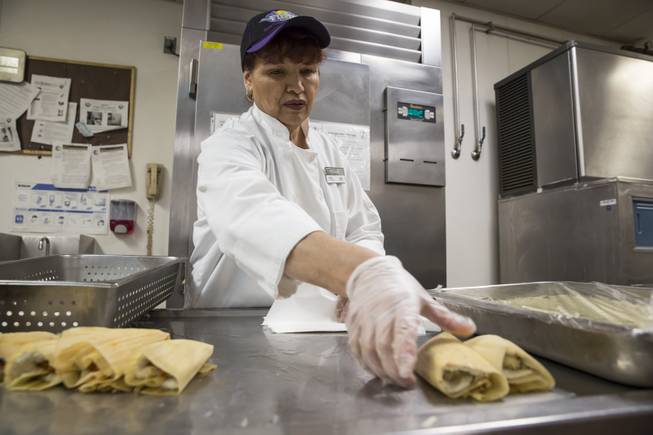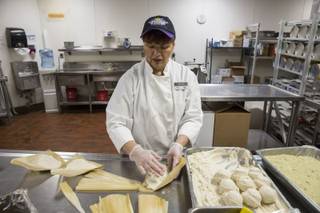
Raquel Flores makes tamales from scratch at Gardunos of Mexico inside the Fiesta Rancho, Tuesday, Jan. 17, 2017.
Wednesday, Feb. 1, 2017 | 2 a.m.
In her white button-up cook’s uniform, dark red hair buried in a baseball cap embroidered with “Fiesta Rancho,” Raquel Flores mixes marinated pork with scoops of masa before folding the combination into thin, soaked corn husks and placing them in a chafer.
She then places the chafer in a steaming machine for 60 minutes to complete a 24-hour process of preparing hot, steaming tamales, a skill she learned from her grandmother as a young girl growing up in Atolinga, a small town in the Mexican state of Zacatecas.
In more than two decades at Garduños at Fiesta Rancho in North Las Vegas, Flores estimates having made 500,000 tamales. Along the way, she’s picked up a pile of awards and countless satisfied customers. Her tamales could be in high demand Thursday on Día de la Candelaria, a Christian holiday and one of major tamales-eating days of the year.
“I want my tamales to be synonymous with satisfaction,” Flores said in Spanish. “I put a lot of care into making them, and when people say they’re the best in town, I’m proud.”
Flores, 60, came to the United States in 1981 as a 24-year-old “in search of a better life.” She took her daughter Marisela, then 3, and infant son Pedro Jr. on a 36-hour bus ride from Atolinga to Tijuana, where they met a smuggler and embarked on a two-day trek through the San Ysidro Mountains. His help across the border cost $1,000.
“That’s really not too expensive for a smuggler, but it was still a lot of money for us,” she reflected.
After reuniting in Pasadena, Calif., with her husband, Pedro, who had left Zacatecas the year before, Flores found work almost instantly at a ceramics factory. The family spent 11 years in Los Angeles area and were granted amnesty by President Ronald Reagan through the Immigration Reform and Control Act of 1986. But even as a green card holder and then as an American citizen, Flores’ dream wasn’t being realized to the fullest.
With her parents and five siblings all living in Las Vegas, Flores came to know the appeal of the valley’s “higher wages and a lower cost of living.” So she brought her family to stay in 1992, initially working on an assembly line and as a housekeeper before landing at Garduños.
“It was just hard to find any stability like that, having to change jobs every couple of years,” Flores said.
More than stability, she said she found her calling at Garduños. Her brother, Victor Serrano, was a cook at the newly opened restaurant and asked the head chef to give his sister a shot. Though she had never worked in a professional kitchen, Flores had cooked for her youngest brother while raising him in Pasadena, filling in after their parents moved to Las Vegas in the mid 1980s.
Día de la Candelaria
In the most modern tradition, families or friends bake a small figurine into the Rosca de Reyes (Kings’ Ring) bread cake and cut the cake into slices on Día de Los Reyes (Three Kings Day also known as the Epiphany), Jan. 6. The person whose slice contains the baked-in figurine is obliged to cook tamales for the others four weeks later on Día de la Candelaria.
When the Garduños of Mexico restaurant staffers divided their Rosca de Reyes bread cake last month, the small figurine turned up in head chef Jesus Lopez’s slice — meaning he’s in charge of making tamales for his fellow employees on Thursday for Día de la Candelaria.
“It’s something we all celebrate and do for fun,” Lopez explained. “Día de la Candelaria is not as serious as some of the other holidays, but we do try to recognize it and do something.”
“She was always hardworking, and I was confident she could learn to cook in big portions,” Serrano, now 42, said. “It was just about getting her the opportunity.”
Her success was almost immediate. Less than two years after she started, the restaurant won its first local award, and has kept winning.
“It just felt right,” said Flores, a mother of three and grandmother of nine. “All of the people here in the kitchen, it was like a big family.”
Despite the departure of eight head chefs in 20 years, the restaurant continues to thrive, and current head chef Jesus Lopez, who took over the position in 2013, gives a lot of credit to Flores.
“You can definitely tell the difference when Raquel is here and when she’s not here,” Lopez said. “It’s especially important to cook tamales the right way, and we’re very happy with her.”
Flores is inspired by her grandmother’s recipe, which reveals a just-right combination of pork marinated in garlic and salt, steamed into the masa. The secret is in her ingredients, which begin the marinating process 24 hours before the tamales find their way out of the Garduños kitchen to customers’ tables.
“First, the masa has to be from corn instead of flour,” she said. “Mine has just salt, baking powder and lard. It keeps its shape and prevents it from breaking while steaming.”
Beyond the pork, chicken and green peppers and cheese tamales — Garduños’ three most popular tamale sellers — Flores said she also enjoys making sweet pineapple tamales and ones with cinnamon and raisins at home for her family. She occasionally eats them, too, though not as often anymore. She used to consume them almost daily.
“I think after so many, you lose that excitement for eating them” she said, laughing. “But I still love making them.”
With no retirement in sight, Flores hopes to continue cooking tamales and other favorite menu items “as long as God lets me.” And with Día de la Candelaria, she said there’s little time to rest.
“Like any big day, I just want to make sure we’re prepared and everybody’s satisfied,” Flores said. “Sometimes there’s no such thing as too many tamales.”

